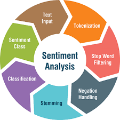Aspect-based sentiment classification (ASC) aims to judge the sentiment polarity conveyed by the given aspect term in a sentence. The sentiment polarity is not only determined by the local context but also related to the words far away from the given aspect term. Most recent efforts related to the attention-based models can not sufficiently distinguish which words they should pay more attention to in some cases. Meanwhile, graph-based models are coming into ASC to encode syntactic dependency tree information. But these models do not fully leverage syntactic dependency trees as they neglect to incorporate dependency relation tag information into representation learning effectively. In this paper, we address these problems by effectively modeling the local and global features. Firstly, we design a local encoder containing: a Gaussian mask layer and a covariance self-attention layer. The Gaussian mask layer tends to adjust the receptive field around aspect terms adaptively to deemphasize the effects of unrelated words and pay more attention to local information. The covariance self-attention layer can distinguish the attention weights of different words more obviously. Furthermore, we propose a dual-level graph attention network as a global encoder by fully employing dependency tag information to capture long-distance information effectively. Our model achieves state-of-the-art performance on both SemEval 2014 and Twitter datasets.
翻译:暂无翻译




